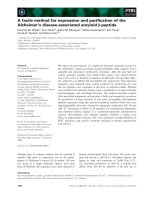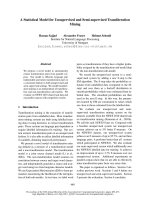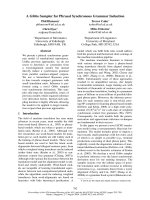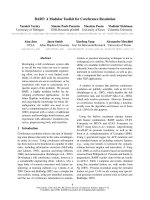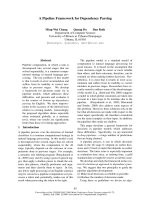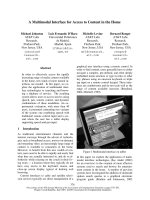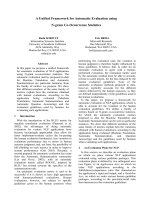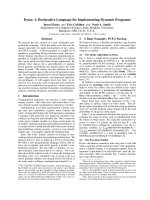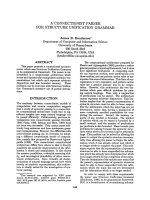Báo cáo khoa học: "A Semantic Framework for Translation Quality Assessment" pptx
Bạn đang xem bản rút gọn của tài liệu. Xem và tải ngay bản đầy đủ của tài liệu tại đây (85.36 KB, 6 trang )
Proceedings of the 49th Annual Meeting of the Association for Computational Linguistics:shortpapers, pages 153–158,
Portland, Oregon, June 19-24, 2011.
c
2011 Association for Computational Linguistics
AM-FM: A Semantic Framework for Translation Quality Assessment
Rafael E. Banchs Haizhou Li
Human Language Technology Department Human Language Technology Department
Institute for Infocomm Research Institute for Infocomm Research
1 Fusionopolis Way, Singapore 138632 1 Fusionopolis Way, Singapore 138632
Abstract
This work introduces AM-FM, a semantic
framework for machine translation evalua-
tion. Based upon this framework, a new
evaluation metric, which is able to operate
without the need for reference translations,
is implemented and evaluated. The metric
is based on the concepts of adequacy and
fluency, which are independently assessed
by using a cross-language latent semantic
indexing approach and an n-gram based
language model approach, respectively.
Comparative analyses with conventional
evaluation metrics are conducted on two
different evaluation tasks (overall quality
assessment and comparative ranking) over
a large collection of human evaluations in-
volving five European languages. Finally,
the main pros and cons of the proposed
framework are discussed along with future
research directions.
1 Introduction
Evaluation has always been one of the major issues
in Machine Translation research, as both human
and automatic evaluation methods exhibit very
important limitations. On the one hand, although
highly reliable, in addition to being expensive and
time consuming, human evaluation suffers from
inconsistency problems due to inter- and intra-
annotator agreement issues. On the other hand,
while being consistent, fast and cheap, automatic
evaluation has the major disadvantage of requiring
reference translations. This makes automatic eval-
uation not reliable in the sense that good transla-
tions not matching the available references are
evaluated as poor or bad translations.
The main objective of this work is to propose
and evaluate AM-FM, a semantic framework for
assessing translation quality without the need for
reference translations. The proposed framework is
theoretically grounded on the classical concepts of
adequacy and fluency, and it is designed to account
for these two components of translation quality in
an independent manner. First, a cross-language la-
tent semantic indexing model is used for assessing
the adequacy component by directly comparing the
output translation with the input sentence it was
generated from. Second, an n-gram based language
model of the target language is used for assessing
the fluency component.
Both components of the metric are evaluated at
the sentence level, providing the means for defin-
ing and implementing a sentence-based evaluation
metric. Finally, the two components are combined
into a single measure by implementing a weighted
harmonic mean, for which the weighting factor can
be adjusted for optimizing the metric performance.
The rest of the paper is organized as follows.
Section 2, presents some background work and the
specific dataset that has been used in the experi-
mental work. Section 3, provides details on the
proposed AM-FM framework and the specific met-
ric implementation. Section 4 presents the results
of the conducted comparative evaluations. Finally,
section 5 presents the main conclusions and rele-
vant issues to be dealt with in future research.
153
2 Related Work and Dataset
Although BLEU (Papineni et al., 2002) has be-
come a de facto standard for machine translation
evaluation, other metrics such as NIST (Dodding-
ton, 2002) and, more recently, Meteor (Banerjee
and Lavie, 2005), are commonly used too. Regard-
ing the specific idea of evaluating machine trans-
lation without using reference translations, several
works have proposed and evaluated different ap-
proaches, including round-trip translation (Somers,
2005; Rapp, 2009), as well as other regression- and
classification-based approaches (Quirk, 2004; Ga-
mon et al., 2005; Albrecht and Hwa, 2007; Specia
et al., 2009).
As part of the recent efforts on machine transla-
tion evaluation, two workshops have been organiz-
ing shared-tasks and evaluation campaigns over the
last four years: the NIST Metrics for Machine
Translation Challenge
1
(MetricsMATR) and the
Workshop on Statistical Machine Translation
2
(WMT); which were actually held as one single
event in their most recent edition in 2010.
The dataset used in this work corresponds to
WMT-07. This dataset is used, instead of a more
recent one, because no human judgments on ade-
quacy and fluency have been conducted in WMT
after year 2007, and human evaluation data is not
freely available from MetricsMATR.
In this dataset, translation outputs are available
for fourteen tasks involving five European lan-
guages: English (EN), Spanish (ES), German (DE),
French (FR) and Czech (CZ); and two domains:
News Commentaries (News) and European Par-
liament Debates (EPPS). A complete description
on WMT-07 evaluation campaign and dataset is
available in Callison-Burch et al. (2007).
System outputs for fourteen of the fifteen sys-
tems that participated in the evaluation are availa-
ble. This accounts for 86 independent system
outputs with a total of 172,315 individual sentence
translations, from which only 10,754 were rated
for both adequacy and fluency by human judges.
The specific vote standardization procedure de-
scribed in section 5.4 of Blatz et al. (2003) was
applied to all adequacy and fluency scores for re-
moving individual voting patterns and averaging
votes. Table 1 provides information on the corre-
sponding domain, and source and target languages
1
2
for each of the fourteen translation tasks, along
with their corresponding number of system outputs
and the amount of sentence translations for which
human evaluations are available.
Task Domain Src. Tgt. Syst. Sent.
T1 News CZ EN 3 727
T2 News EN CZ 2 806
T3 EPPS EN FR 7 577
T4 News EN FR 8 561
T5 EPPS EN DE 6 924
T6 News EN DE 6 892
T7 EPPS EN ES 6 703
T8 News EN ES 7 832
T9 EPPS FR EN 7 624
T10 News FR EN 7 740
T11 EPPS DE EN 7 949
T12 News DE EN 5 939
T13 EPPS ES EN 8 812
T14 News ES EN 7 668
Table 1: Domain, source language, target lan-
guage, system outputs and total amount of sentence
translations (with both adequacy and fluency hu-
man assessments) included in the WMT-07 dataset
3 Semantic Evaluation Framework
The framework proposed in this work (AM-FM)
aims at assessing translation quality without the
need for reference translations, while maintaining
consistency with human quality assessments. Dif-
ferent from other approaches not using reference
translations, we rely on a cross-language version of
latent semantic indexing (Dumais et al., 1997) for
creating a semantic space where translation outputs
and inputs can be directly compared.
A two-component evaluation metric, based on
the concepts of adequacy and fluency (White et al.,
1994) is defined. While adequacy accounts for the
amount of source meaning being preserved by the
translation (5:all, 4:most, 3:much, 2:little, 1:none),
fluency accounts for the quality of the target lan-
guage in the translation (5:flawless, 4:good, 3:non-
native, 2:disfluent, 1:incomprehensible).
3.1 Metric Definition
For implementing the adequacy-oriented compo-
nent (AM) of the metric, the cross-language latent
semantic indexing approach is used (Dumais et al.,
1997), in which the source sentence originating the
translation is used as evaluation reference. Accord-
154
ing to this, the AM component can be regarded to
be mainly adequacy-oriented as it is computed on a
cross-language semantic space.
For implementing the fluency-oriented compo-
nent (FM) of the proposed metric, an n-gram based
language model approach is used (Manning and
Schutze, 1999). This component can be regarded to
be mainly fluency-oriented as it is computed on the
target language side in a manner that is totally in-
dependent from the source language.
For combining both components into a single
metric, a weighted harmonic mean is proposed:
AM-FM = AM FM / (
α
AM + (1-
α
) FM) (1)
where
α
is a weighting factor ranging from
α
=0
(pure AM component) to
α
=1 (pure FM compo-
nent), which can be adjusted for maximizing the
correlation between the proposed metric AM-FM
and human evaluation scores.
3.2 Implementation Details
The adequacy-oriented component of the metric
(AM) was implemented by following the proce-
dure proposed by Dumais et al. (1997), where a
bilingual collection of data is used to generate a
cross-language projection matrix for a vector-space
representation of texts (Salton et al., 1975) by
using singular value decomposition: SVD (Golub
and Kahan, 1965).
According to this formulation, a bilingual term-
document matrix X
ab
of dimensions M*N, where
M=(M
a
+M
b
) are vocabulary terms in languages a
and b, and N are documents (sentences in our
case), can be decomposed as follows:
X
ab
= [X
a
;X
b
] = U
ab
Σ
ab
V
ab
T
(2)
where [X
a
;X
b
] is the concatenation of the two
monolingual term-document matrices X
a
and X
b
(of dimensions M
a
*N and M
b
*N) corresponding to
the available parallel training collection, U
ab
and
V
ab
are unitary matrices of dimensions M*M and
N
*N, respectively, and
Σ
is an M*N diagonal matrix
containing the singular values associated to the de-
composition.
From the singular value decomposition depicted
in (2), a low-dimensional representation for any
sentence vector x
a
or x
b
, in language a or b, can be
computed as follows:
y
a
T
= [x
a
;0]
T
U
abM
*
L
(3.a)
y
b
T
= [0; x
b
]
T
U
abM
*
L
(3.b)
where y
a
and y
b
represent the L-dimensional vec-
tors corresponding to the projections of the full-
dimensional sentence vectors x
a
and x
b
, respective-
ly; and U
abM
*
L
is a cross-language projection matrix
composed of the first L column vectors of the
unitary matrix U
ab
obtained in (2).
Notice, from (3a) and (3b), how both sentence
vectors x
a
and x
b
are padded with zeros at each
corresponding other-language vocabulary locations
for performing the cross-language projections. As
similar terms in different languages would have
similar occurrence patterns, theoretically, a close
representation in the cross-language reduced space
should be obtained for terms and sentences that are
semantically related. Therefore, sentences can be
compared across languages in the reduced space.
The AM component of the metric is finally com-
puted in the projected space by using the cosine
similarity between the source and target sentences:
AM = [s;0]
T
P ([0;t]
T
P)
T
/ |[s;0]
T
P| / |[0;t]
T
P| (4)
where P is the projection matrix U
abM
*
L
described
in (3a) and (3b), [s;0] and [0;t] are vector space
representations of the source and target sentences
being compared (with their target and source
vocabulary elements set to zero, respectively), and
| | is the L2-norm operator. In a final implementa-
tion stage, the range of AM is restricted to the
interval [0,1] by truncating negative results.
For computing the projection matrices, random
sets of 10,000 parallel sentences
3
were drawn from
the available training datasets. The only restriction
we imposed to the extracted sentences was that
each should contain at least 10 words. Seven pro-
jection matrices were constructed in total, one for
each different combination of domain and lan-
guage pair. TF-IDF weighting was applied to the
constructed term-document matrices while main-
taining all words in the vocabularies (i.e. no stop-
words were removed). All computations related to
SVD, sentence projections and cosine similarities
were conducted with MATLAB.
3
Although this accounts for a small proportion of the datasets
(20% of News and 1% of European Parliament), it allowed for
maintaining computational requirements under control while
still providing a good vocabulary coverage.
155
The fluency-oriented component FM is imple-
mented by using an n-gram language model. In
order to avoid possible effects derived from dif-
ferences in sentence lengths, a compensation factor
is introduced in log-probability space. According
to this, the FM component is computed as follows:
FM = exp(
Σ
n=1:N
log(p(w
n
|w
n-1
,…))/N) (5)
where p(w
n
|w
n-1
,…) represent the target language
n-gram probabilities and N is the total number of
words in the target sentence being evaluated.
By construction, the values of FM are also re-
stricted to the interval [0,1]; so, both component
values range within the same interval.
Fourteen language models were trained in total,
one per task, by using the available training data-
sets. The models were computed with the SRILM
toolbox (Stolcke, 2002).
As seen from (4) and (5), different from con-
ventional metrics that compute matches between
translation outputs and references, in the AM-FM
framework, a semantic embedding is used for as-
sessing the similarities between outputs and inputs
(4) and, independently, an n-gram model is used
for evaluating output language quality (5).
4 Comparative Evaluations
In order to evaluate the AM-FM framework, two
comparative evaluations with standard metrics
were conducted. More specifically, BLEU, NIST
and Meteor were considered, as they are the met-
rics most frequently used in machine translation
evaluation campaigns.
4.1 Correlation with Human Scores
In this first evaluation, AM-FM is compared with
standard evaluation metrics in terms of their corre-
lations with human-generated scores. Different
from Callison-Burch et al. (2007), where Spear-
man’s correlation coefficients were used, we use
here Pearson’s coefficients as, instead of focusing
on ranking; this first evaluation exercise focuses on
evaluating the significance and noisiness of the
association, if any, between the automatic metrics
and human-generated scores.
Three parameters should be adjusted for the
AM-FM implementation described in (1): the di-
mensionality of the reduced space for AM, the or-
der of n-gram model for FM, and the harmonic
mean weighting parameter α. Such parameters can
be adjusted for maximizing the correlation coeffi-
cient between the AM-FM metric and human-
generated scores.
4
After exploring the solution
space, the following values were selected, dimen-
sionality for AM: 1,000; order of n-gram model for
FM: 3; and, weighting parameter α: 0.30
In the comparative evaluation presented here,
correlation coefficients between the automatic met-
rics and human-generated scores were computed at
the system level (i.e. the units of analysis were sys-
tem outputs), by considering all 86 available sys-
tem outputs (see Table 1). For computing human
scores and AM-FM at the system level, average
values of sentence-based scores for each system
output were considered.
Table 2 presents the Pearson’s correlation coef-
ficients computed between the automatic metrics
(BLEU, NIST, Meteor and our proposed AM-FM)
and the human-generated scores (adequacy, fluen-
cy and the harmonic mean of both; i.e. 2af/(a+f)).
All correlation coefficients presented in the table
are statistically significant with p<0.01 (where p is
the probability of getting the same correlation
coefficient, with a similar number of 86 samples,
by chance).
Metric Adequacy Fluency H Mean
BLEU
0.4232 0.4670 0.4516
NIST 0.3178 0.3490 0.3396
Meteor 0.4048 0.3920 0.4065
AM-FM 0.3719 0.4558 0.4170
Table 2: Pearson’s correlation coefficients (com-
puted at the system level) between automatic met-
rics and human-generated scores
As seen from the table, BLEU is the metric ex-
hibiting the largest correlation coefficients with
human-generated scores, followed by Meteor and
AM-FM, while NIST exhibits the lowest correla-
tion coefficient values. Recall that our proposed
AM-FM metric is not using reference translations
for assessing translation quality, while the other
three metrics are.
In a similar exercise, the correlation coefficients
were also computed at the sentence level (i.e. the
units of analysis were sentences).
These results are
summarized in Table 3. As metrics are computed
4
As no development dataset was available for this particular
task, a subset of the same evaluation dataset had to be used.
156
at the sentence level, smoothed-bleu (Lin and Och,
2004) was used in this case.
Again, all correlation
coefficients presented in the table are statistically
significant with p<0.01.
Metric Adequacy Fluency H Mean
sBLEU 0.3089
0.3361 0.3486
NIST 0.1208 0.0834 0.1201
Meteor
0.3220
0.3065 0.3405
AM-FM 0.2142 0.2256 0.2406
Table 3: Pearson’s correlation coefficients (com-
puted at the sentence level) between automatic
metrics and human-generated scores
As seen from the table, in this case, BLEU and
Meteor are the metrics exhibiting the largest
correlation coefficients, followed by AM-FM and
NIST.
4.2 Reproducing Rankings
In addition to adequacy and fluency, the WMT-07
dataset includes rankings of sentence translations.
To evaluate the usefulness of AM-FM and its
components in a different evaluation setting, we
also conducted a comparative evaluation on their
capacity for predicting human-generated rankings.
As ranking evaluations allowed for ties among
sentence translations, we restricted our analysis to
evaluate whether automatic metrics were able to
predict the best, the worst and both sentence trans-
lations for each of the 4,060 available rankings
5
.
The number of items per ranking varies from 2 to
5, with an average of 4.11 items per ranking. Table
4 presents the results of the comparative evaluation
on predicting rankings
.
As seen from the table, Meteor is the automatic
metric exhibiting the largest ranking prediction
capability, followed by BLEU and NIST, while our
proposed AM-FM metric exhibits the lowest rank-
ing prediction capability. However, it still performs
well above random chance predictions, which, for
the given average of 4 items per ranking, is about
25% for best and worst ranking predictions, and
about 8.33% for both. Again,
recall that the AM-
FM metric is not using reference translations,
while the other three metrics are. Also, it is worth
mentioning that human rankings were conducted
5
We discarded those rankings involving the translation system
for which translation outputs were not available that, conse-
quently, only had one translation output left.
by looking at the reference translations and not the
source. See
Callison-Burch et al. (2007) for details
on the human evaluation task.
Metric Best Worst Both
sBLEU 51.08% 54.90% 37.86%
NIST 49.56% 54.98% 37.36%
Meteor
52.83% 58.03% 39.85%
AM-FM 35.25% 41.11% 25.20%
AM 37.19% 46.92% 28.47%
FM 34.01% 39.01% 24.11%
Table 4: Percentage of cases in which each auto-
matic metric is able to predict the best, the worst,
and both ranked sentence translations
Additionally, results for the individual compo-
nents, AM and FM, are also presented in the table.
Notice how the AM component exhibits a better
ranking capability than the FM component.
5 Conclusions and Future Work
This work presented AM-FM, a semantic frame-
work for translation quality assessment. Two com-
parative evaluations with standard metrics have
been conducted over a large collection of human-
generated scores involving different languages.
Although the obtained performance is below stand-
ard metrics, the proposed method has the main
advantage of not requiring reference translations.
Notice that a monolingual version of AM-FM is
also possible by using monolingual latent semantic
indexing (Landauer et al., 1998) along with a set of
reference translations. A detailed evaluation of a
monolingual implementation of AM-FM can be
found in Banchs and Li (2011).
As future research, we plan to study the impact
of different dataset sizes and vector space model
parameters for improving the performance of the
AM component of the metric. This will include the
study of learning curves based on the amount of
training data used, and the evaluation of different
vector model construction strategies, such as re-
moving stop-words and considering bigrams and
word categories in addition to individual words.
Finally, we also plan to study alternative uses of
AM-FM within the context of statistical machine
translation as, for example, a metric for MERT
optimization, or using the AM component alone as
an additional feature for decoding, rescoring and/or
confidence estimation.
157
References
Joshua S. Albrecht and Rebeca Hwa. 2007. Regression
for sentence-level MT evaluation with pseudo
references. In Proceedings of the 45
th
Annual
Meeting of the Association of Computational
Linguistics, 296-303.
Rafael E. Banchs and Haizhou Li. 2011. Monolingual
AM-FM: a two-dimensional machine translation
evaluation method. Submitted to the Conference on
Empirical Methods in Natural Language Processing.
Satanjeev Banerjee and Alon Lavie. 2005. METEOR:
an automatic metric for MT evaluation with
improved correlation with human judgments. In
Proceedings of the ACL Workshop on Intrinsic and
Extrinsic Evaluation Measures for MT and/or
Summarization, 65-72.
John Blatz, Erin Fitzgerald, George Foster, Simona
Gandrabur, Cyril Goutte, Alex Kulesza, Alberto
Sanchis and Nicola Ueffing. 2003. Confidence
estimation for machine translation. Final Report
WS2003 CLSP Summer Workshop, Johns Hopkins
University
Chris Callison-Burch, Cameron Fordyce,Philipp Koehn,
Christof Monz and Josh Schroeder. 2007. (Meta-)
evaluation of machine translation. In Proceedings of
Statistical Machine Translation Workshop, 136-158.
George Doddington. 2002. Automatic evaluation of
machine translation quality using n-gram co-
occurrence statistics. In Proceedings of the Human
Language Technology Conference.
Susan Dumais, Thomas K. Landauer and Michael L.
Littman. 1997. Automatic cross-linguistic
information retrieval using latent semantic indexing.
In Proceedings of the SIGIR Workshop on Cross-
Lingual Information Retrieval, 16-23.
Michael Gamon, Anthony Aue and Martine Smets.
2005. Sentence-level MT evaluation without
reference translations: beyond language modeling. In
Proceedings of the 10
th
Annual Conference of the
European Association for Machine Translation, 103-
111.
G. H. Golub and W. Kahan. 1965. Calculating the
singular values and pseudo-inverse of a matrix.
Journal of the Society for Industrial and Applied
Mathematics: Numerical Analysis, 2(2):205-224.
Thomas K. Landauer, Peter W. Foltz and Darrell
Laham. 1998. Introduction to Latent Semantic
Analysis. Discourse Processes, 25:259-284.
Chin-Yew Lin and Franz Josef Och. 2004. Orange: a
method for evaluating automatic evaluation metrics
for machine translation. In Proceedings of the 20th
international conference on Computational
Linguistics, pp 501, Morristown, NJ.
Christopher D. Manning and Hinrich Schutze. 1999.
Foundations of Statistical Natural Language
Processing (Chapter 6). Cambridge, MA: The MIT
Press.
Kishore Papineni, Salim Roukos, Todd Ward and Wei-
Jung Zhu. 2002. BLEU: a method for automatic
evaluation of machine translation. In Proceedings of
the Association for Computational Linguistics, 311-
318.
Christopher B. Quirk. 2004. Training a sentence-level
machine translation confidence measure. In
Proceedings of the 4
th
International Conference on
Language Resources and Evaluation, 825-828.
Reinhard Rapp. 2009. The back-translation score:
automatic MT evaluation at the sentences level
without reference translations. In Proceedings of the
ACL-IJCNLP, 133-136.
Gerard M. Salton, Andrew K. Wong and C. S. Yang.
1975. A vector space model for automatic indexing.
Communications of the ACM, 18(11):613-620.
Harold Somers. 2005. Round-trip translation: what is it
good for? In proceedings of the Australasian
Language Technology Workshop, 127-133.
Lucia Specia, Craig Saunders, Marco Turchi, Zhuoran
Wang and John Shawe-Taylor. 2009. Improving the
confidence of machine translation quality estimates.
In Proceedings of MT Summit XII. Ottawa, Canada.
Andreas Stolcke. 2002. SRILM - an extensible language
modeling toolkit. In Proceedings of the International
Conference on Spoken Language Processing.
John S. White, Theresa O’Cornell and Francis O’Nava.
1994. The ARPA MT evaluation methodologies:
evolution, lessons and future approaches. In
Proceedings of the Association for Machine
Translation in the Americas, 193-205.
158
